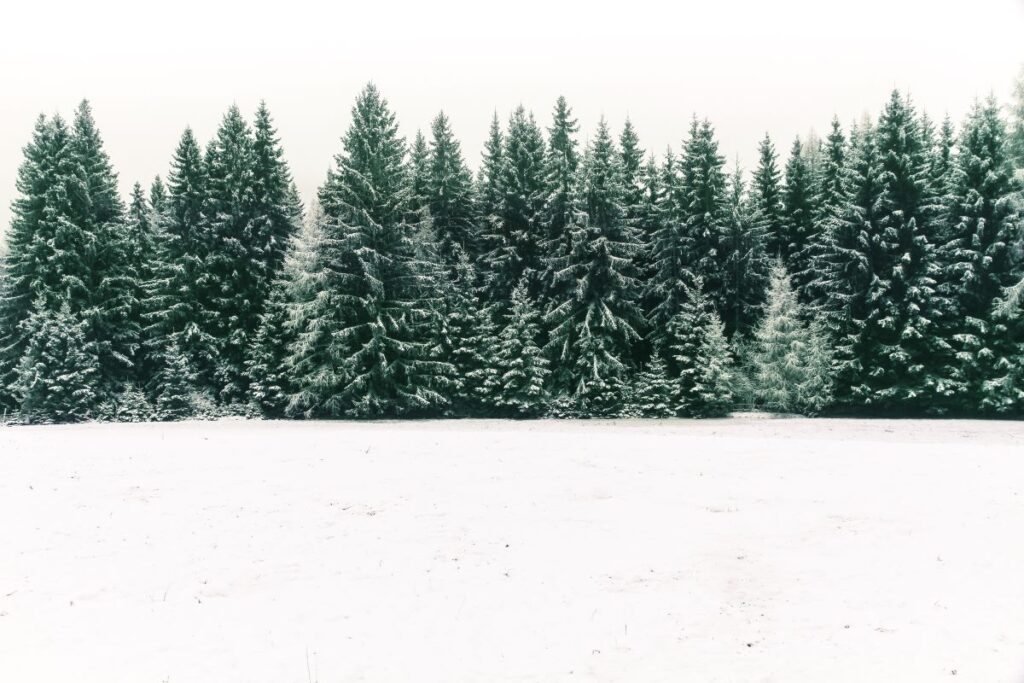
Section by section, I lug the plastic, decapitated Christmas tree up from the basement. This is a joyless precursor to the part I love: each of us carefully hanging our favorite ornaments, stepping back, adjusting, and then sinking into the couch and gazing at years of Christmases.
But I miss having a real tree.
I miss finding it: the excursion, hopefully in the snow; walking up and down the assembled forest, looking so closely—too scrawny, not fat enough, crooked, ahhh—here’s one that’s perfect! Never perfect, in the literal sense, because it is real, and as flawed as we are. But perfect for us, the ideal houseguest in a temporary adoption that never fails to thrill me. A big ol’ tree, a piece of the woods, brought inside our home!
I miss the smell. The awkward watering, sometimes on my belly. The way it becomes The Tree, as though named, almost familial—Did you turn The Tree off? Let’s sit by The Tree. Thoreau felt the same kinship: “My eye wanders across the valley to the pine woods which fringe the opposite side,” he told his journal on a chilly late November day, “and in their aspect my eye finds something which addresses itself to my nature.”
The plastic tree does not address itself to my nature. True, we both have limbs, and it stands taller and outdoes me in symmetry. But it feels as kindred as a wig on a Styrofoam head. While Thoreau takes pleasure from “the infinite stories of their boughs, tier above tier,” I mutter that Tier B goes right below the top, tossing the bundle of bristly fake boughs onto the area rug and heading back down to the basement for the next one. When we had a real tree, I used to murmur an automatic apology if I banged into one of the branches. These are inert and cannot be wounded.
Still, they are—or at least represent—pine trees, the species Taoists saw as a symbol of vitality. In Greek mythology, Zeus made the feat of staying evergreen a consolation prize, because in a fit of pique, Cybele had turned her lover into a pine tree. Yet in Russia, a branch of pine was believed to keep a marriage evergreen—fresh and alive—and fertile. In Eastern Europe, poachers munched a pinecone every morning, believing it would help them dodge or survive a landowner’s gunshot. Here, many First Nations saw pine trees as trees of life, sacred trees, symbols of wisdom and longevity and peace.
My father died when I was eight months old. What helped me love him from a distance was hearing quirky details, like the way he drilled holes in the Christmas tree and stuck in extra boughs. A little American, a little aggressive and over the top—but I bet that tree looked fantastic. At first I worried that the extra boughs would have turned brown. Then I read about the Scots pine, the most widely distributed in the world, growing from above the Arctic Circle to southern Spain and from western Scotland to Siberia. Not only are pine boughs long-lived, but if a Scots pine dies while it is still standing, its skeleton can stay upright as long as a century, because its wood is so slow to decay.
Our plastic tree is, I suppose, even sturdier. It was made for eternal life. It holds our heaviest ornaments without drooping. With a real tree, finding the right branch was a careful series of tests and quick grab-backs. You had to respect The Tree’s limits, study its anatomy, find and use its strength.
Thoreau built his house from young white pines by Walden Pond. His hands grew so sticky with resin that his buttered bread at lunchtime smelled of pine. His best room, though, remained the pine wood behind his house. He used it as a “withdrawing room,” entertaining distinguished summer guests in its soft-carpeted shade. It was a place of integrity: “Nothing stands up more free from blame in this world than a pine tree,” he wrote in a late December journal entry.
Stretched out on the sofa, I gaze up at our pretty tree. I sense no integrity, feel no life. So I put on my hiking boots, yell for the dog, and go in search of a clump of pines growing at the edge of a lake. The winter afternoon sunshine brightens their needles, and they tower over any tree-lot tree, and I decide they prefer it here anyway. Who am I to cut down a tree and drag it into my living room, stare at it for a month, then toss it on the compost?
Thoreau knew: “Every creature is better alive than dead, men and moose and pine trees.”
Read more by Jeannette Cooperman here.
